Prairie Memories and reveries III, Post and Image creators as noted.
Prairie is where you find it, by Deborah Naslund
Growing up in Illinois, I lamented the disappearance of the vast prairie that used to cover the mid-western landscape. In college, I volunteered to help with research on a remnant tall grass prairie. It was a wondrous experience to walk through the tall grass that reached over my head, but disappointing that this prairie was maybe one acre in size! I also enjoyed wandering through the Forest Preserves in our area, set aside in the 1920’s and still dominated by native oaks.
When I moved to Seattle in the early 1980’s, I was surprised and delighted to find prairies and oak woodlands right here in western Washington. Since the early 2000’s I’ve been fortunate to have the chance to volunteer out at Glacial Heritage Preserve and on various other South Sound prairies. In those days, I was working full time with two kids at home, so it was the occasional “Second Saturday” work parties that I joined, and, of course, helping as I could with Prairie Appreciation Day. When I retired in 2016, I was delighted to have the opportunity to join the Tuesday volunteer group.
Prairie Appreciation Day is always the highlight of my prairie volunteering year. So many fun memories of sharing booths with friends, old and new, and of weather ranging from fantastic, to too hot and sunny, to cold, soaking rain, and everything in between. But it’s always the opportunity to share the wonders of the prairie with all the wildly enthusiastic participants that keeps me coming back.
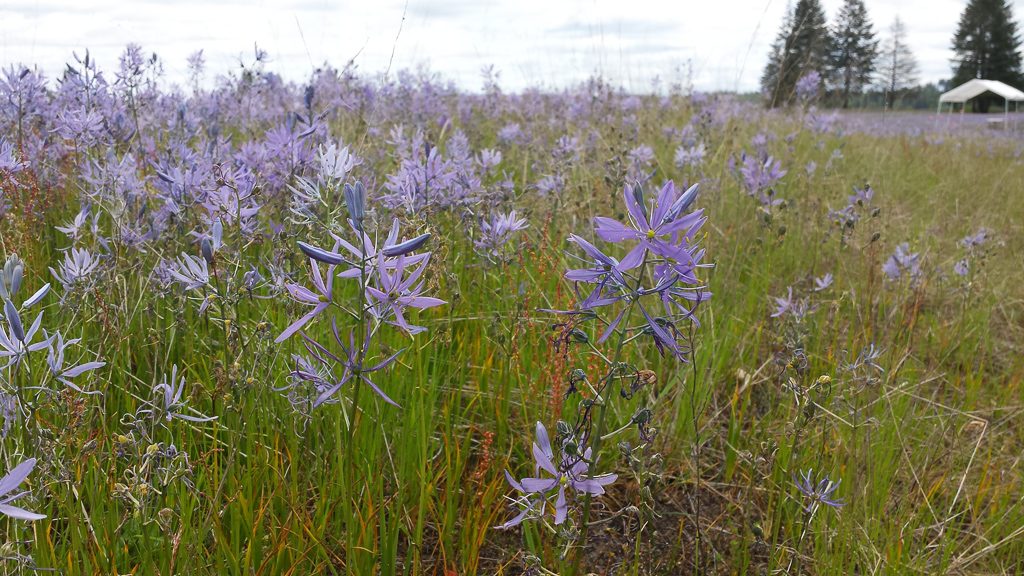
Glacial Heritage Preserve, Prairie Appreciation Day set-up, 2018.
One of my places to work is the “Oaks on the Prairie” station. In addition to getting to share with folks the story of our beautiful oaks and their weird galls, I love the enthusiasm and curiosity everyone has for the oak gall ink. Kids of all ages love to try writing in oak gall ink using quill pens, (almost) just like the authors of the Declaration of Independence. Last year, people visiting our booth used oak gall ink and quill pens to make this poster celebrating Prairie Appreciation Day.
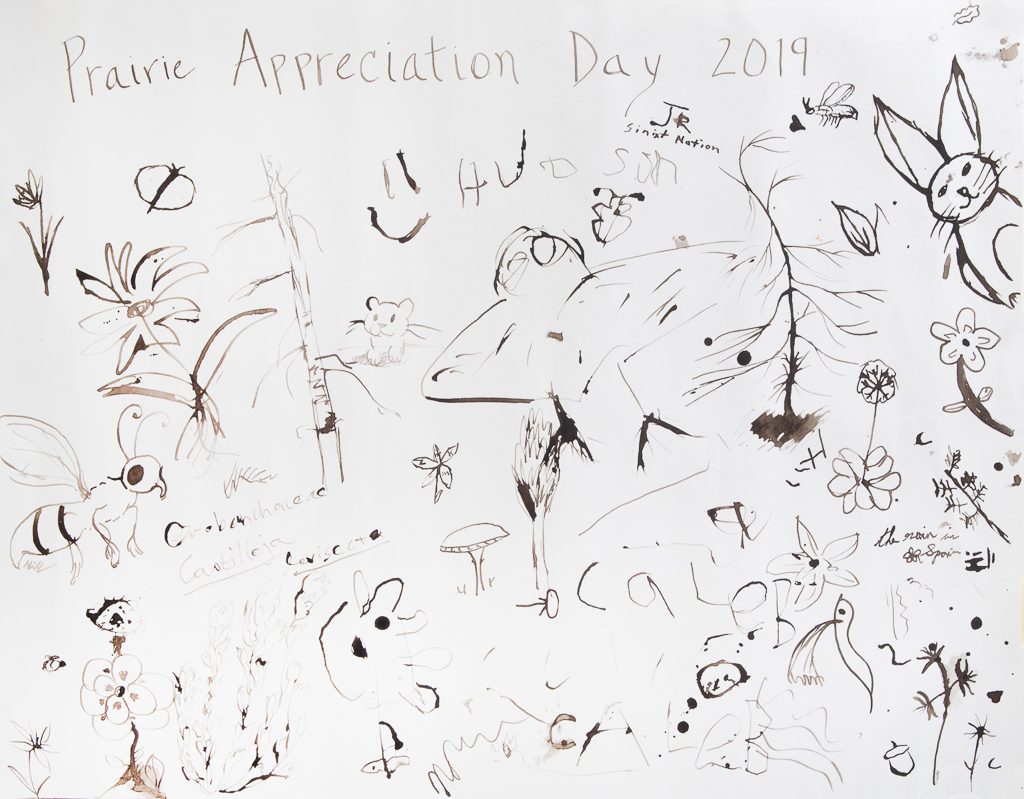
Prairie Appreciation Day poster drawn in oak gall ink, Photo by Dennis Plank
The land has memories of the prairies and oak woodlands, too. Prior to European settlement, prairies and Garry oak (Quercus garrryana) woodlands covered extensive areas in a swath, from Georgia Basin in British Columbia, through the Puget Trough, down to the Willamette Valley in Oregon. Now the Garry oak woodland/prairie ecosystem is one of the rarest in North America.
However, especially this time of year, we can still see remaining slivers of this ecosystem shining through here and there all around Thurston County.
Last week I ran from home, down Delphi Road SW. At the corner of Alpine Drive SW and Delphi Road SW, in the ditch, is a profusion of camas, blooming through the tall, weedy grass. There were even some wild strawberries in bloom, too.
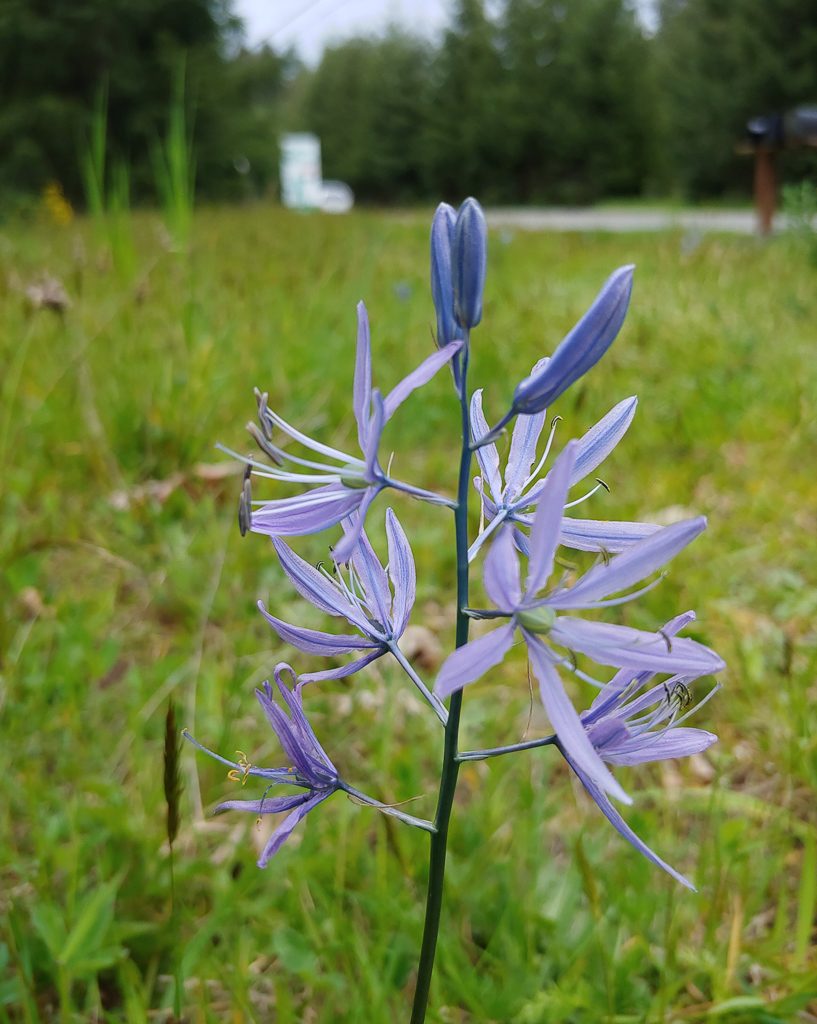
Common camas (Camassia quamash) in the ditch along Delphi Road SW. Photo by Deborah Naslund
Further up the road, to the north, clumps of craggy oaks persist here and there. Under some oaks above the road cut, just out of the mower’s reach, I was delighted to find a patch of Oregon fawn lilies (Erythronium oregonum) in bloom.
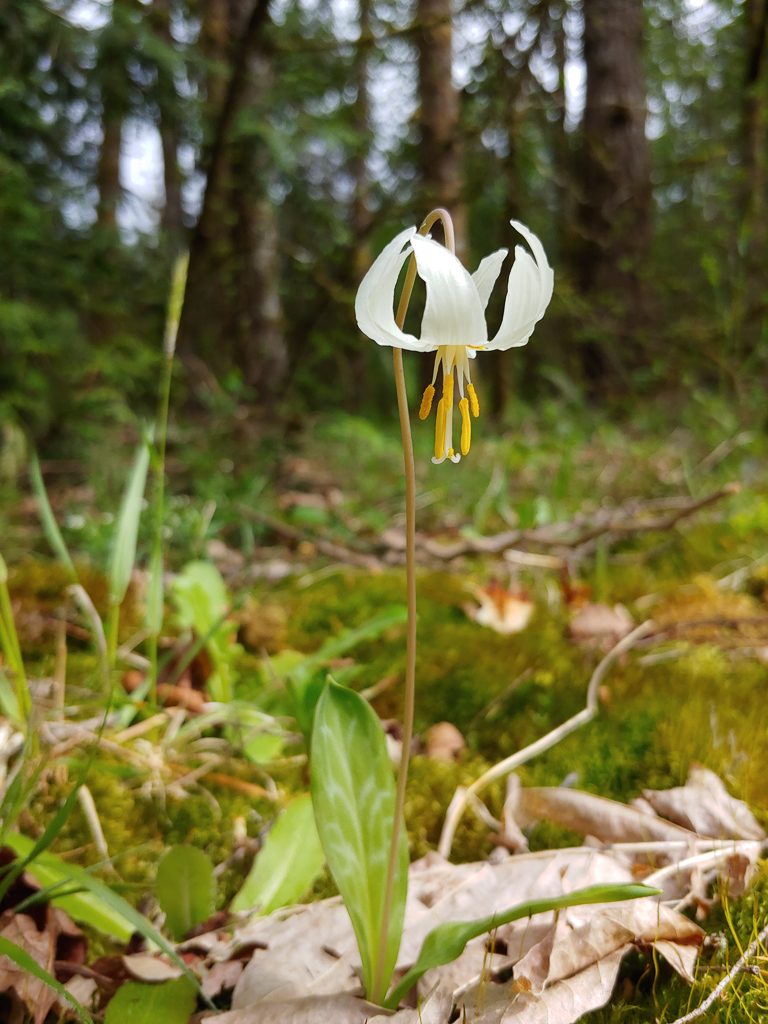
Oregon fawn lily (Erythronium oregonum) having escaped the road maintenance crew. Photo by Deborah Naslund
Riding my bike out Steamboat Island Road NW, I found another lovely surprise. Across the street from the fire station was a field of camas in full glory. It is evident that someone has been working hard to control the Scot’s broom in this area, creating space for the camas to flourish.
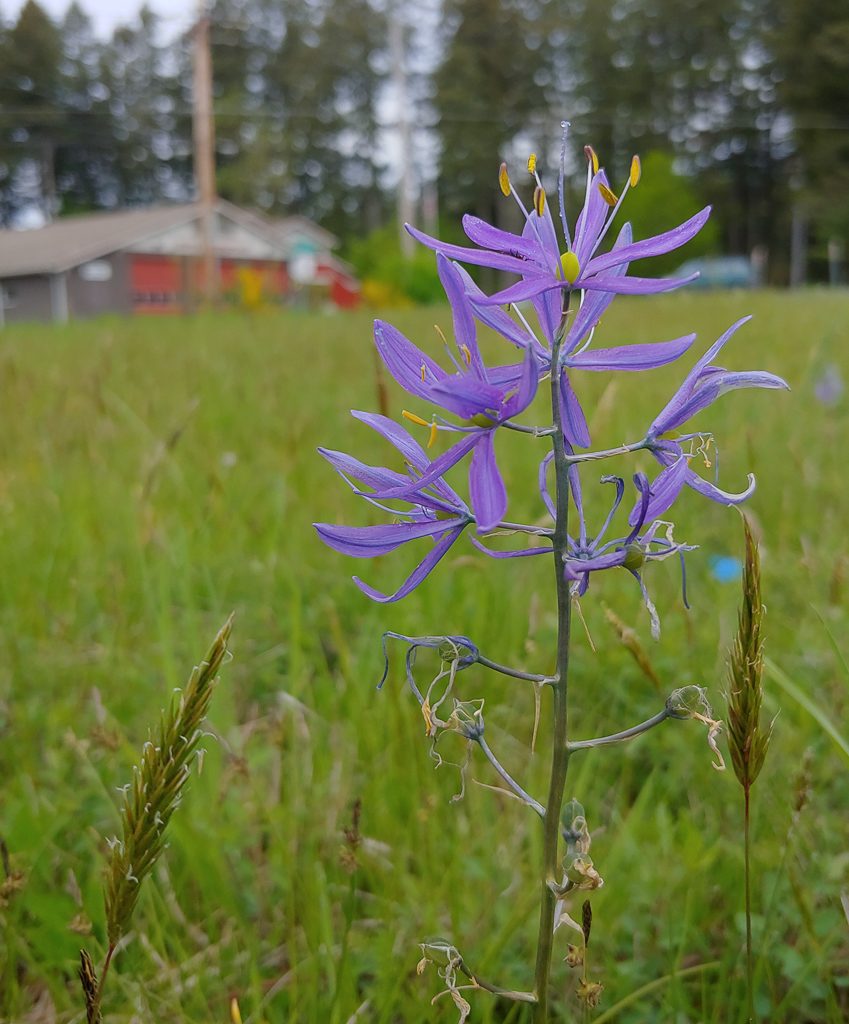
Common camas (Camassia quamash) in a field across from the Griffin Fire Department. Photo by Deborah Naslund
Later in the week, as I drove south on Delphi Rd., I was delighted to see the old Delphi School standing in a lush carpet of camas, blooming with abandon.
On a bike ride this week, south of Millersylvania State Park, I found camas blooming in profusion in several fields and beautiful stands of Garry oak just leafing out.
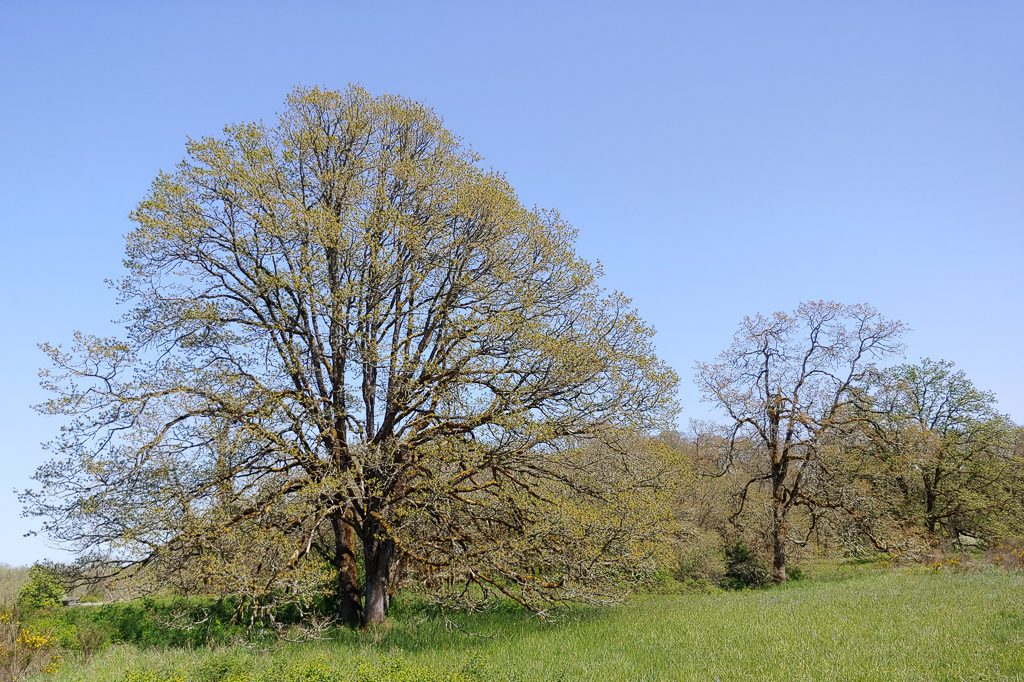
Garry oak (Quercus garryana) stand along Leitner Rd SW, near Scatter Creek. Photo by Deborah Naslund
Now that our public lands have re-opened, we can visit the jewels of our South Sound landscape, set aside to preserve larger tracts of prairie and oak woodland, like Mima Mounds Natural Area Preserve and Scatter Creek Wildlife Area. But I challenge you to keep your eyes out for those hidden gems, tiny slivers of what once was, shining through with oaks leafing out and prairie wildflowers in full bloom.
A Life with the Prairie!
Jennifer K Lyne, EdD
After teaching public schools orchestra for 44 years, Jennifer Lyne is retired, living in Olympia.
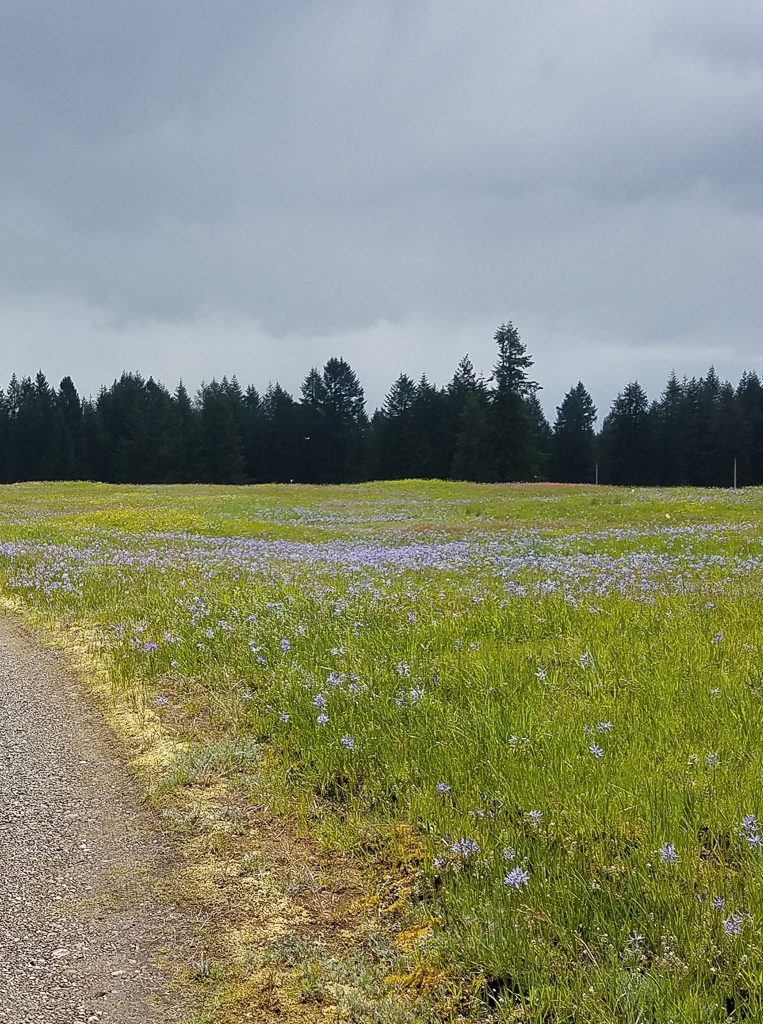
Glacial Heritage on Prairie Appreciation Day. Photo by Jennifer Lyne
I LOVE Prairie Days! I had lived in Olympia for years before friends invited me to attend Prairie Days. I couldn’t believe that I hadn’t known about it – I was completely addicted from that point on!
Walking the trails on that first visit, I was amazed at the amount of preparation volunteers had done to provide so many educational displays for participants. Considerations were made for all sorts of weather, age, and ability levels. I love the tractor-drawn hay trailer that allows people of all abilities to BE IN the prairie! And it is just fun to ride on the wagon!
As we made our way farther down the path, I experienced the beauty of spirit that the gorgeousness and quiet of the Prairie exudes. The passion for the Prairie that was demonstrated by visitors and volunteers was contagious, and I also really enjoyed the quiet space as we walked farther. Near the river, I loved the docent who explained to us about the fire and how the oaks are fire resistant – often having a 10 foot tap root!!! Even though the top of the oak was burned, it was able to withstand the fire!
Spring of 2012 I ended up at Prairie Days by myself. The beautiful space provided an opportunity for me to reflect on the life and death of my father, who had died in January. It was good to be there with people who also love the Prairie, and it was also good to be alone as I traveled farther away from the displays. It was good to be in the wonderfulness of such a beautiful place as I was learning to live without my father. I remember coming across huge ant hills that I hadn’t noticed other years. I was surprised that I hadn’t ever noticed them before, but realized that perhaps I was simply viewing the Prairie (and many things) with a different focus.
I so look forward the Prairie Days now. I especially like to buy native plants and my yearly Prairie Days support shirt! Mostly, the weather is terrific (I probably jinxed that now, saying it out loud!) It’s breath-taking to see the delicate hues of the blooming camas as far as I can see! It’s a time when we Northwesterners are finally convinced that summer is actually coming! Last year I was able to help set up for the event – that was really fun! I couldn’t believe how many people volunteered! It takes a lot of organization and work – and, WOW! Is it ever worth it! Thank you Prairie Days!
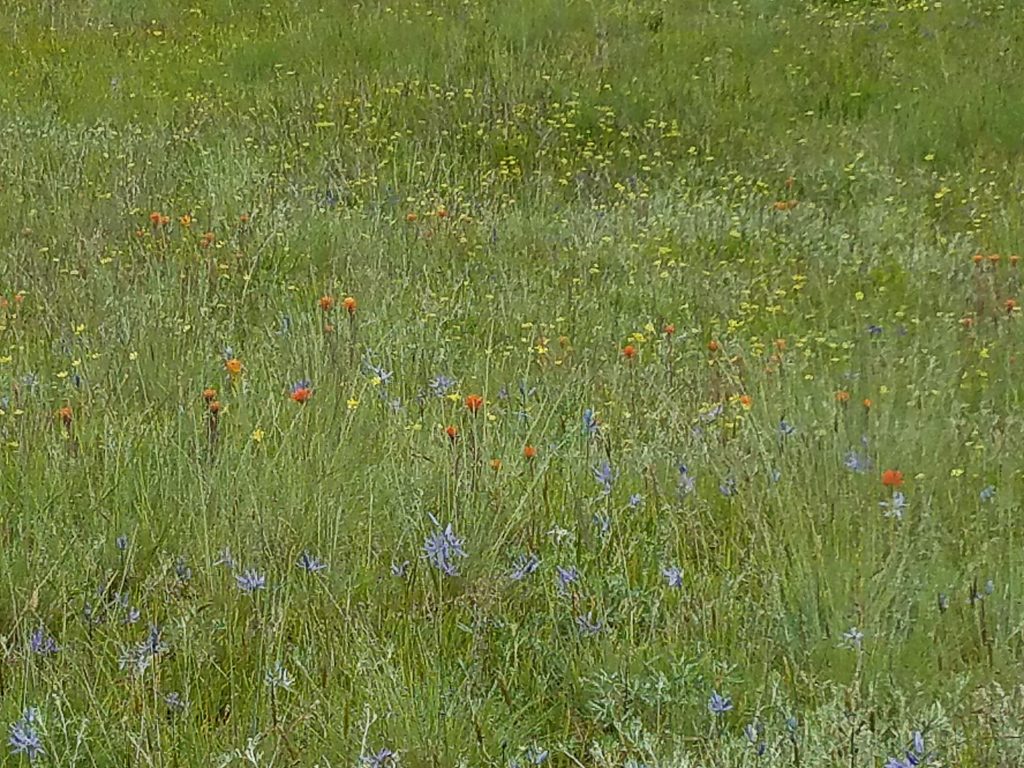
Flowers in Bloom at Prairie Appreciation Day, Photo by Jennifer Lyne
Camas Prairie by Elizabeth Pagan

Camas. Photo by
In 2011 we purchased a small part of the Prairie. Six acres didn’t seem like much compared to the 21 acres we had owned previously in north central Washington.
When I found the property the For Sale realtor sign was knocked over and buried in a tangle of foot tall grass and weeds. A year later, and two listing realtors we made an offer.
We were looking for acreage to support our love of country living and to accommodate our mule. We took possession of the property in July. Long past camas blooms. The property was basically six acres of grassland, with just four evergreen trees behind the house.
We moved our riding mule to the property in September once we got some preliminary fencing done. Fencing here was easier said than done. Of course if you live near the Scatter Creek prairies or near the Glacial till areas you soon discover the abundance of buried rocks and small boulders that challenge any digging efforts beyond several inches. However we were grateful for challenges that were NOT posed here as in north central WA-like rattlesnakes, cactuses, noxious weeds like Russian knapweed and puncture vines who’s thorn can actually puncture your tractor or car tires. None of those things we missed.
We embraced the Prairie with all its fauna and flora. Summer soon became fall, fall eased into winter. Then came Spring.
We walked our property daily. Each morning, with coffee cups in hand we started observing our land. We started recognizing some plants – Phlox, Yarrow, Prairie rockets, Ladies Mantle. We were also learning the weeds of the prairie-notably Scotch broom -asking questions of neighbors and friends.
In April we started observing spots of bluish buds. Two weeks later we observed larger spots of blooms, from pale to purple bluish blossoms. As the days passed we had acres in camas. We stopped mowing. We read up on the uses of their oniony bulbs. We learned about camas ovens that our indigenous people used to roast the bulbs. We felt blessed.
Eight years have come and gone. We are still learning the soils, the various micro-climates on our property. We still feel blessed that we can be stewards of our small piece of this precious home planet.

A field of Camas. Photo by Elizabeth Pagan


Deb, an inspiring post. Finding and sharing the prairie remnants gives hope – that as many of the prairie species persist, and there is a dedicated group of volunteers, maybe this once grand ecosystem can be restored. Thank you for all the work you do